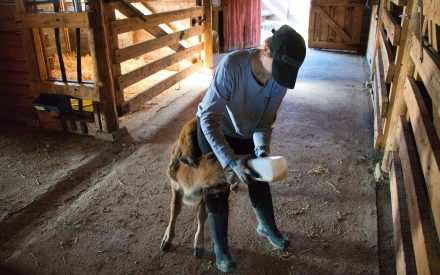Article Series
Recent farm succession research by UW-Madison Division of Extension educators indicates that the division of assets for inheritance is a common tension around farm succession planning. This study found that 54% of participants felt stress over how assets were divided. The participants’ comments regarding this stress were grouped into five main categories, business risk, sibling harmony, emotions, personal risk, and treating assets strictly as inheritance and not as business assets.
In some cases, the tension can be so great that the owner generation avoids making a decision until it’s too late which may allow their assets to default to the state’s plan, which typically mandates dividing the assets equally between the children. If the goal is to continue the farm to the next generation, dividing the assets equally may jeopardize that. Oklahoma State University has created a statistical model that compares various transition strategies and their probabilities of success. The results demonstrate that the most common farm succession strategy of dividing the assets equally among all heirs has the lowest success rate. Farms employing this strategy normally do not continue to the next generation1.
Making decisions and following through with them can alleviate the successor’s worry about their financial ability to purchase the farm assets. Having a succession plan allows the successor to prepare for ownership of the farm assets, whether it is through inheritance, purchase, lifetime gifting, or a combination of the three.
Solidifying the owner generation’s goals and priorities for their retirement needs and estate plan, allows them to better communicate these goals to the heirs and/or business successors. Service providers, such as attorneys, accountants or other professionals can use these goals to tailor their suggestions and strategies to better fit the needs of the family.
An overview of the following tools and strategies is provided to help owners and successors become familiar with these options before meeting with planning professionals. Familiarity with these tools and strategies will give owners and successors a better understanding of the strategies as they discuss them with professionals. Farm families may want to consider a combination of these strategies to fit their unique asset distribution needs.
Unequal Gifts of Essential Business Property
Owners of the farm business may choose to transfer the essential assets of the business to the on-farm heir. These assets may include livestock, machinery and equipment, tools, and buildings that are critical to the business. For a business to survive, these things may need to be passed on to the business heir even if this means the business heir inherits a larger percentage of the parent’s assets.
Estate planning tools (Wills,Trusts, and ownership of property)
Wills are a set of instructions for the distribution of assets at the time of death. Wills are easily changed, and assets distributed through a will are subject to probate. Probate is the court process of validating the will. The instructions in the will can distribute assets however the owner deems appropriate and can set parameters for the purchase of assets between heirs. Parameters could include a set price, a formula for a price, and an interest rate if a purchase is done over time like a land contract. The instructions may also include that assets be available for the on-farm heir to rent for a set period of time.
A trust is a legal entity that has the power to hold assets. Trustees and beneficiaries need to be identified for each trust that is created. A set of instructions would be developed outlining who makes decisions for the assets and who receives the assets or the benefits generated by the assets after the owners pass. Assets in a trust are not subject to probate, unlike assets that are transferred by a will or by the state’s default plan. Depending on the type of trust, the date the trust was implemented, and the trustees and beneficiaries chosen, a trust may provide some protection against Medicaid Recovery in Wisconsin. Any assets moved to a trust would still be subject to the Medicaid programs “look back” period or may still be considered the owners’ assets, despite being held in the trust name. For more information about Medicaid Recovery visit: https://www.dhs.wisconsin.gov/medicaid/erp.htm
The way the property is owned or titled may have a bearing on how it is distributed. For example, if property is owned as tenancy in common, and one of the owners dies, the deceased’s interest is transferred to his/her heirs. Joint tenancy exists when two or more persons own the entire property with the right of survivorship. This means that at the death of one joint tenant, his or her interest passes directly to the surviving joint tenant(s). It does not become a part of the decedent’s probate estate. Therefore, it cannot be controlled by his or her will and is not subject to creditors’ claims against the estate. The last surviving joint tenant becomes the sole owner of the property2. If one is unsure of how property is titled and owned, a consult with an attorney can be helpful.
Business Entities as Transfer Vehicles
Corporations, limited liability companies (LLCs), and limited partnerships may be an option to transfer business assets to the on-farm heirs. The assets in the entity could be transferred to the successor over time allowing the owner and successor to co-own the entity. The transfer of ownership could be achieved by selling shares of the entity in the case of corporations or interest or units in the case of LLCs. The owner could choose to gift ownership of shares, interests, or units to the successor. The purchasing or gifting of shares, interests, or units guarantees the essential business assets are in the appropriate hands. The entity can also have language in the operating agreement or legal documents as to how the owners’ shares or interest are to be transferred at death. It is important to consult with an accountant or tax professional regarding gifting and sales transactions that may have tax consequences.
Purchasing Agreements
There are many different types of purchase agreements. We will discuss the pros and cons of the following purchase agreements: right of first refusal, first option to buy, option to purchase/option to buy, and buy-sell agreements.
The right of first refusal is a legal document that provides the person holding it the right to purchase property before anyone else. A right of first refusal requires the seller to provide documentation of a legitimate offer to purchase to the person who owns the right of first refusal. The person with the right of first refusal has the opportunity to say they will match the offer and buy the property or they can refuse it and the property can be sold to the person who made the original purchase offer.
Pro: The right of first refusal allows the seller to ask fair market value of the property if they want. The right of first refusal also allows the holder of the right the opportunity to purchase the property before those without the right.
Cons: This type of agreement provides no price protection to the person with the right of first refusal. The right of first refusal does not require the owner to sell the property. The property may never be for sale during the potential buyer ‘s lifetime or when they wish to and are financially able to do so. Right of first refusal requires the involvement of a third party to make a legitimate offer. This can create disputes, for instance, from an unhappy potential third party. It has the potential for abuse in regards to whether the price offered was legitimate. Right of first refusal can also impact the seller’s value because a third party buyer may be unwilling to make an offer when they know that the right of first refusal holder will be able to match it.
The first option to buy sounds similar to the right of first refusal but is not the same thing. The first option to buy names an heir or heirs who have the right to purchase the property if they desire. It can be granted like the right of first refusal and can be “triggered” by events defined in the document, including but not limited to the death of the owner. There is often a time period in which the sale must take place. The document can specify if the property is to be sold at fair market value, at a set price, or a formula is provided to determine the price at something less than fair market value.
Pros: This may provide enough protection for the on-farm heir to retain the business property if they have the cash or ability to borrow.
Cons: Depending on how many heirs there are, the on-farm heir may not receive enough of the assets to leverage a loan to purchase the assets or interests held by the others.
An option to purchase/option to buy is another possibility. This option gives the buyer the right to purchase property according to agreed-upon terms and conditions within a set time frame.
Pros: This option gives the buyer more control, as they own the option to purchase but are not required to exercise that option.
Cons: The property may never be for sale during the potential buyer ‘s lifetime or when they wish to and are financially able to do so.
A buy-sell agreement is a document that allows, or in some instances, requires, the seller to sell and the buyer to buy the assets outlined in the agreement. The buy-sell agreement is triggered by events defined in the document, such as death, disability, termination of employment, retirement, or sometimes a divorce. The agreement outlines a set of procedures or rules for determining the purchase price, paying the purchase price and time frames for the process. Life insurance can be obtained to assist in payment of the purchase price in the case of death as a trigger (sometimes referred to as being “funded” with life insurance), but usually payment terms (for instance, requiring the seller take payments over time) will need to be set for triggers other than death or if the life insurance has expired or is no longer sufficient to cover the purchase price. Many times the buy-sell agreement has language that provides a discounted price because it is a closely-held business, to reflect the lack of marketability of the interest and/or that the portion at issue represents a minority interest in the business. A closely-held business is one that is owned by a small number of people who typically have a common interest in the business (i.e., family members).
Buy-sell agreements can provide that the other owners are the “buyers” (sometimes referred to as “cross purchase”), that the entity itself is the buyer (sometimes referred to as a “redemption”), or alternating opportunities between the entity and the individual owners. Many times a buy-sell agreement is included in entity documents, such as the corporation by-laws, the LLCs operating agreement or the partnership agreement. However, buy-sell agreements can also be standalone documents between parties, such as owner-employee agreements.
Pro: The agreement is designed to guarantee that ownership and control of the business stays in the family. The agreement also ensures the seller has a buyer when they want to leave the business.
Con: If not property planned, funding the agreement can still be difficult
Purchasing agreements need to be considered by both sides to be enforceable. Therefore, these rights outlined above, unless granted in an estate plan document, are going to require either a payment, need to be tied to another business deal, or require the holder of the right to give something up in order to receive this benefit. It is common for the right of first refusal to be granted as a part of a sale or a lease arrangement. For example: “I’ll buy this 40 acres from you now for $x, on the condition you give me a right of first refusal on your other acerage.”
Valuation of the Property
Valuation of the property can be a point of tension between the parties for any of the strategies. Methods for determining the value can include:
- Getting an appraisal from a company that deals with agricultural entities on a regular basis can give an honest valuation of the property. A combination of appraisals, one paid for by the owner, one paid for by the buyer, and a third one could be averaged to determine a value for the property. Appraisals can be expensive and it might be difficult to find three competent farm asset appraisers in the geographic area.
- Matching from another bid (as in the right of first refusal)
- Using an agreed-upon formula. For example, it could be based on fair market value with a percentage discount because of the closely held business
- Valuing of the assets on an annual basis. For example, the farm partners/owners could set and agree upon the value of the assets at the beginning of the year. If there is a triggering event during that year, the value set at the beginning of the year is used for the buy-sell agreement.
- Basing the value on the enterprise’s profitability and cash flow potential.
Life Insurance
Life insurance is a tool that can help to balance inheritance for some farm families3. Owners may purchase insurance and make non-farm heirs the beneficiaries so the business assets can go to the on-farm heirs. If assets are equally distributed in the parents’ estate plan, life insurance can be used by the on-farm heir to purchase assets from siblings or out of the estate. It is helpful to document the reason for identifying the off-farm heirs as the beneficiaries to clearly explain the use of the insurance as a way to attempt to balance the inheritances to their heirs.This will not fully balance the inheritances.
Farm owners must consider the amount of debt that is on the farm assets, when considering the estate and balancing the inheritance. Owners then need to evaluate the fairness of the off-farm heirs receiving all the cash/liquid assets and the on-farm heir receiving the farm assets along with all the debt.
Careful planning is required so the insurance doesn’t become part of the estate probate process or any federal or state taxes that may be owed. If the on-farm heir intends to use the insurance to purchase assets, then the on-farm heir should own the policy on the lives of the owners/parents. Parents could gift the policy payment to the on-farm heir if they want to help with the cost. However, policy payments should be made by the on-farm heir to the insurance company.
The increase in land values over the last 15 – 20 years has made it unrealistic for many farm families to purchase enough insurance to make the distribution completely equal. But having some life insurance can help with paying off debts, costs associated with settling the estate, and funeral expenses2 so that the family doesn’t have to decide who is going to pay for these costs during a very stressful time.
It is also important to realize that if planning hasn’t started early enough, the owner generation may be of an age and health status where life insurance costs are prohibitive or life insurance is unavailable.
Planning for a farm succession is a daunting task because parents want to treat their children equally. With the majority of the parent’s assets wrapped up in the farm business assets, equal division of assets may result in the farm not being passed to the next generation. If the goal of the owners is to see the farm continue in the family it becomes important to separate the farm business and personal assets. Clear and honest communication between all of the heirs is important. This conversation should happen early while there is time to plan. Planning early gives the owners options that are not available if they wait. Planning early also allows for thorough conversations among owners and heirs, which will increase sibling harmony after the assets are divided.
Reviewed by:
John Baker, Staff Attorney for the Iowa Concern Hotline, Iowa State University
Bridget Finke, Attorney and Partner of Valley Crossing Law, Baldwin, Wisconsin
Resources
- Reed, Garret, J. 2017. Assessing The Rate of Success of Alternative Farm Transition Strategies. Oklahoma State University. Master’s Thesis
- https://cdn.shopify.com/s/files/1/0145/8808/4272/files/B1442.pdf
- https://www.agriculture.com/farm-management/estate-planning/using-life-insurance-in-estate-planning

 Farm asset division a 21st-century conundrum
Farm asset division a 21st-century conundrum What is the biggest threat to a farm estate getting to the rightful heirs? It’s probably not what you think
What is the biggest threat to a farm estate getting to the rightful heirs? It’s probably not what you think Sweat equity and farming
Sweat equity and farming What are the Tax Implications of Sweat Equity Arrangements on Wisconsin Farms?
What are the Tax Implications of Sweat Equity Arrangements on Wisconsin Farms?


